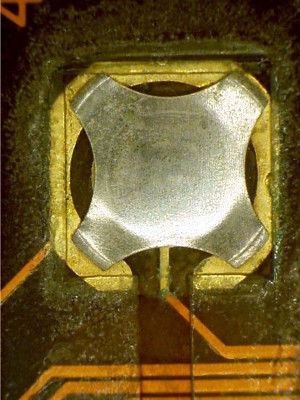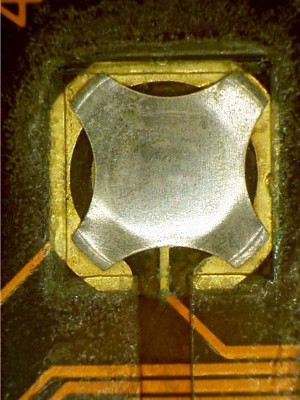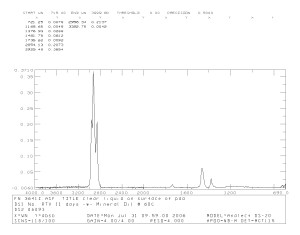Polyimide Silicone Adhesive Contamination
Gideon Analytical Labs received a contaminated white translucent adhesive at the edge of a polyimide strip under a rubber keypad. Since most of the materials were organic, FTIR was the method of analysis first used to determine the foreign material.
The polyimide is a double-sided adhesive based flexible laminate (Kapton) film coated with adhesive on one or both and laminated to copper. There are two kinds of adhesive used in flex, epoxy, and acrylic. They each have positive and negative attributes that may make one or the other more suitable for a specific end use. The polyimide film enables the flex to bend many millions of cycles without failure. However, both acrylic and epoxy adhesives have inferior mechanical and electrical properties as compared to the Kapton core. In certain applications, the presence of an adhesive layer actually inhibits the use of flexible circuits. Therefore, a solution was needed to eliminate the adhesive layer from the substrate.
The white translucent silicone adhesives and contain a large amount of either a higher molecular weight triglyceride (oil) or a mixture of mineral oil and a lower molecular weight triglyceride.
Upon examination under a stereo-zoom microscope, it was found that there is a clear liquid on the metal surface of the pad. The liquid gave the spectrum in Figure 1. These show absorptions due to aliphatic hydrocarbon oil with a very small ester carbonyl band at 1733 Cm-1. The clear adhesive on the underside PET film gave the spectrum in Figure 3. This shows absorptions due to mainly poly(2-octyl acrylate) and a small amount of acrylic acid. The 1733 C-1 peak may be from this adhesive.
Other FTIR spectra of the white translucent adhesive (silicone adhesive) at the edge of the polyimide strip gave a modified silicone with a large amount of mineral oil. After extraction, the spectrum showed absorptions due to mineral oil and silicone oligomers.
Other FTIR spectra of the white translucent adhesive at the edge of the polyimide strip was analyzed to show absorptions due to the silicone, an aliphatic hydrocarbon-containing component, an ester carbonyl band at 1745 Cm-1 and various amounts zinc stearate.
The white translucent adhesive at the edge of the polyimide strip from each sample was extracted. The soluble portion gave the spectra many extractions. These are similar to one another. These show absorptions due to the silicone oligomers and a second component, that is either a higher molecular weight triglyceride or a mixture of mineral oil and a lower molecular weight triglyceride.
All the samples contained either mineral oil or similar type oil commonly used in skin lotion, sun tan lotion (coconut oil), and many other skin care products. These types of products contain high molecular weight saturated triglycerides and mineral oil."
Gideon Analytical Labs can solve many organic contamination problems. Many scans and extractions are necessary to distinguish absorbed contaminants. Our experience and database can help to elucidate these contaminants into a single spectrum and solve your contamination issue.

Polyimide with Silicone Adhesive

Polyimide with Silicone Adhesive

Aliphatic Hydrocarbon Oil